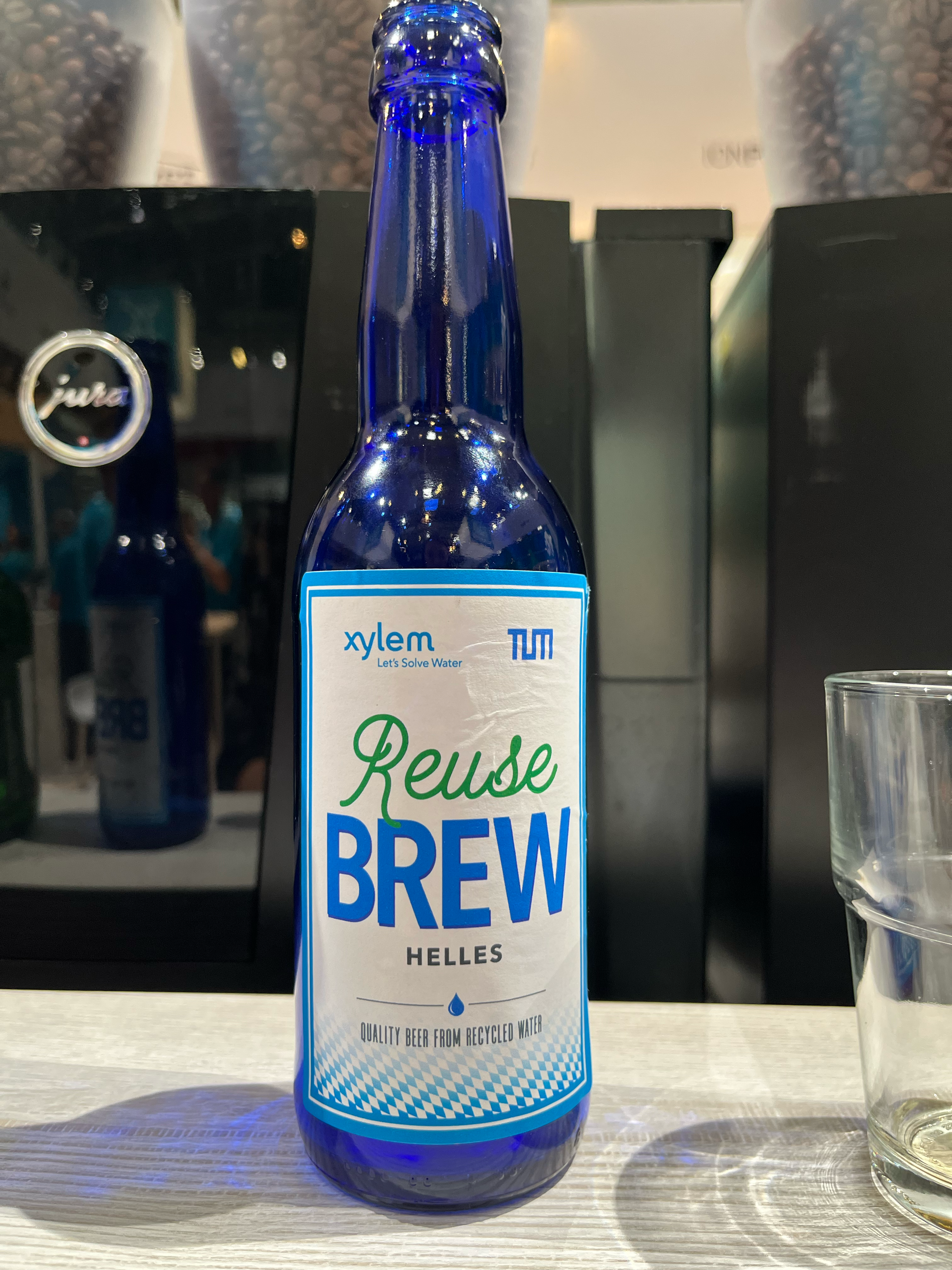18 Jun 2024
Follow Hilary Hall’s Churchill Fellowship travel blog
RMCG Senior Consultant Hilary Hall is travelling throughout Europe from April to June 2024 to investigate technology and policy approaches that enhance the beneficial use of biosolids.
Hilary’s Fellowship from the Winston Churchill Trust (Australia) will focus on biosolids, a by-product of sewage treatment and a valuable source of nutrients, organic matter and beneficial microbes for our soils.
Biosolids are an excellent example of circular resources, however this circularity is threatened by contamination from chemicals used in our food, clothing, cosmetics and pharmaceuticals. Solving this problem will take a multilateral approach, including government policy, environmental regulation, source control and technology solutions.
Hilary hopes her learnings contribute to better outcomes for biosolids management in Australia, improving resource recovery for the benefit of water utilities, farmers and communities.
A Churchill Fellowship offers Australian citizens and permanent residents a life-changing opportunity to travel overseas for four to eight weeks to learn more about a topic or issue that they are passionate about. You can read more about Hilary’s Fellowship or see this recent article from the Australian Water Association.
Follow Hilary’s blog below to receive the latest updates from her travels.
26 April 2024: Welcome!
Welcome to my biosolids travel blog. As I undertake my Fellowship, I’ll share a few posts about my journey throughout Europe and the UK, as I seek to understand biosolids treatment, regulation and use in this part of the world.
I’m looking forward to learning about different regulatory approaches, and what biosolids problems they have (and haven’t!) solved.
Map and itinerary
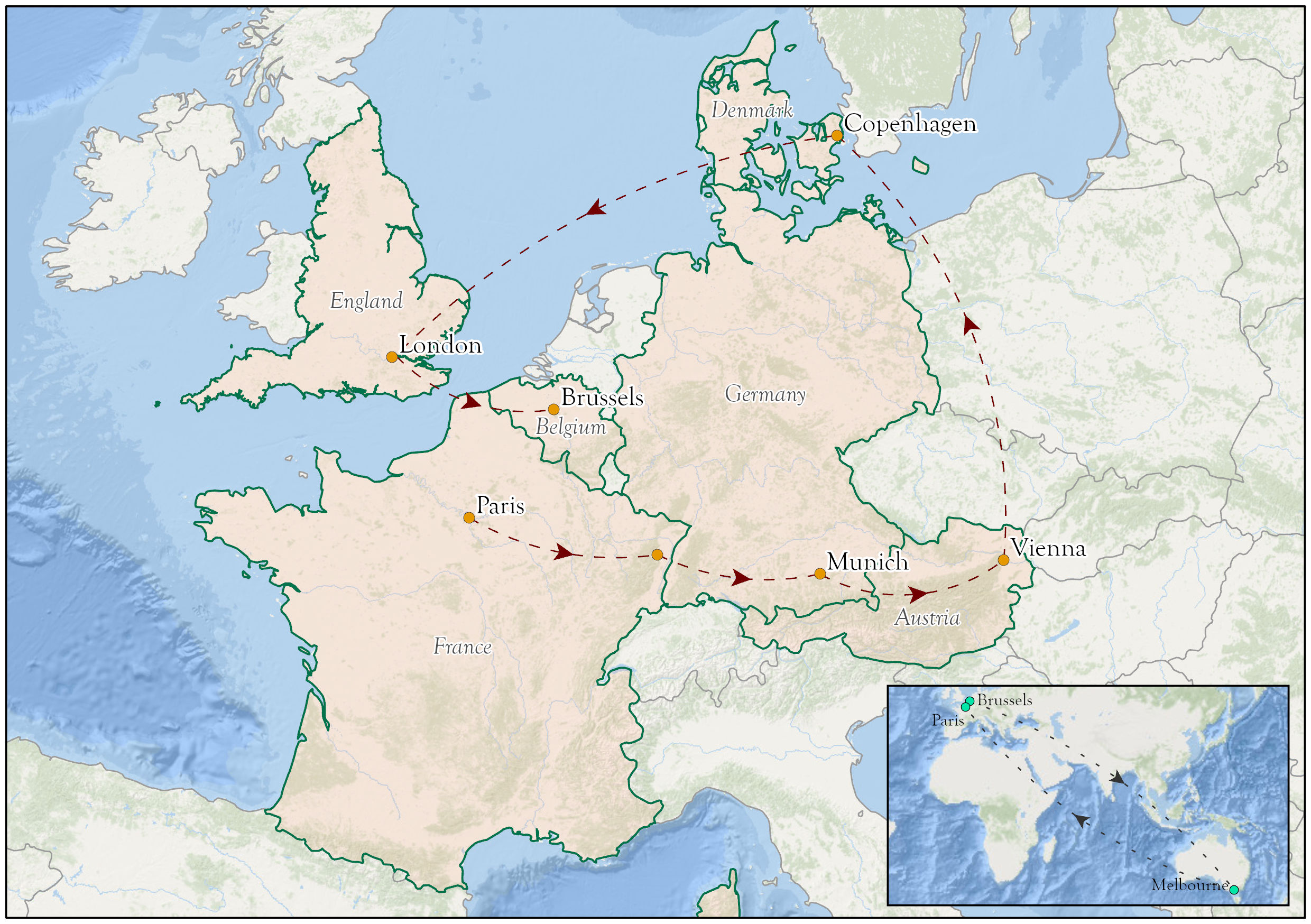
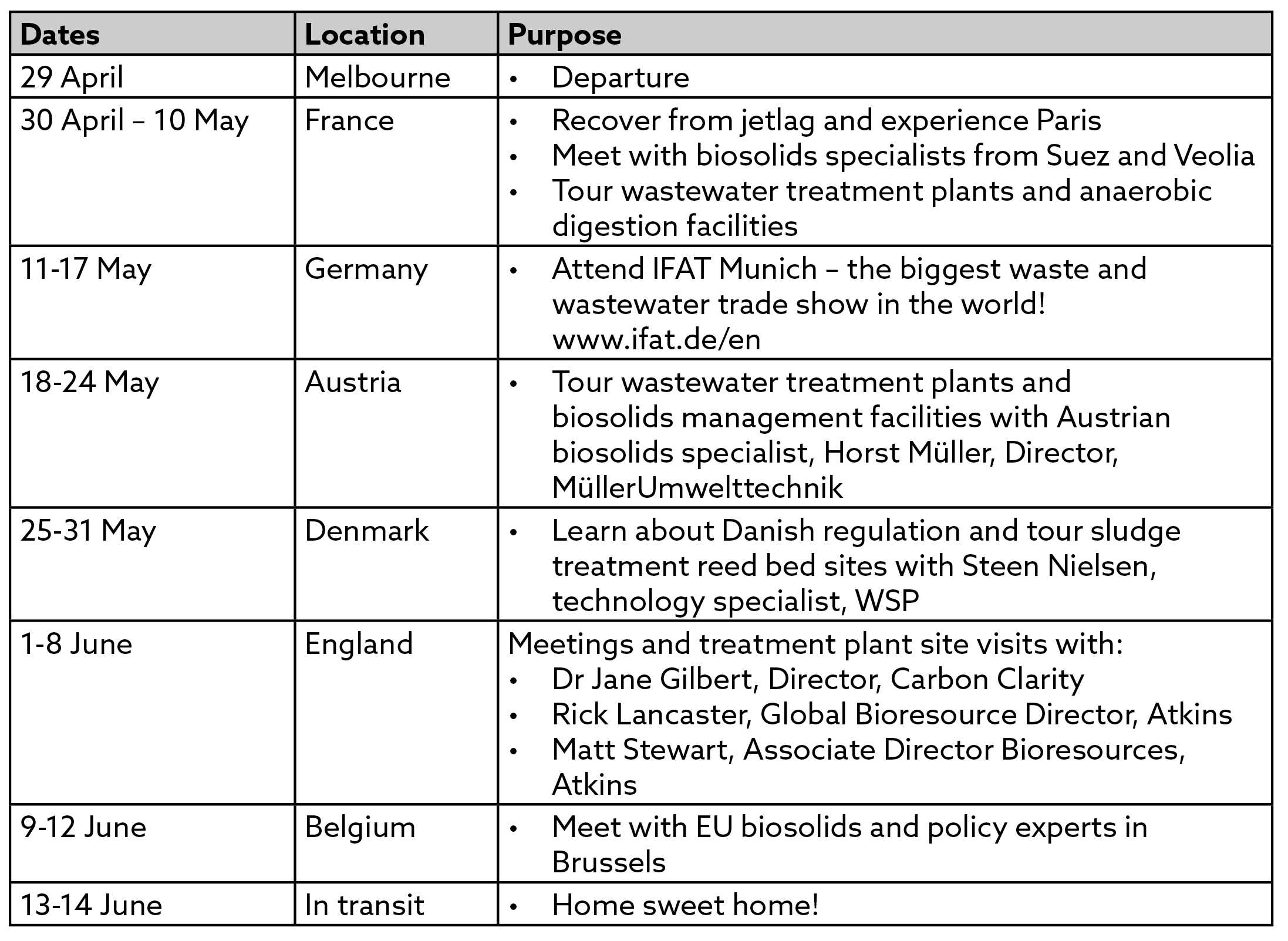
10 May 2024: Bonjour from France!
The Paris Sewer Museum seemed like a good place to start my Fellowship tours. Yes, this is really a thing, there were lots of other visitors there, and it is a real, live, operational sewer!
Paris has a combined wastewater and stormwater system, and large underground galleries (photo 1) have been built over the last 150 years to provide sufficient capacity for wastewater and stormwater collection. Although the ‘modern’ sewer system has been developed in this time, the city has a history of conveyancing infrastructure dating back to 1370. The sewer galleries run throughout the city, mostly following the streets above, and sit only a few metres below the ground, above the Metro train tunnels.
Initially, wastewater was conveyed to the Seine River, downstream of the city. But during the 1850s, there was keen interest in utilising the nutrients in the wastewater for agriculture, and this led to the construction of an irrigation system eventually covering 50 square kilometres of agricultural land. Untreated wastewater was irrigated onto farmland from 1868 through to the First World War. After this time, direct irrigation was phased out (due to urban encroachment and increasing flows) and replaced with six wastewater treatment plants.
The sewer galleries are filled with an array of fascinating technologies. There is significant grit removal infrastructure, as the galleries have very little gradient and therefore grit accumulates rapidly. The suspended barge (photo 2) is lowered into the flow and used to create an eddy that causes grit to accumulate (photo 3), so that it can be pumped out efficiently. These barges are permanently installed throughout the sewer network and have been in operation since 1865.

The sewer galleries also house thousands of kilometres of water mains, fibre optic cables and other services (photo 4). Paris is serviced by both potable water and non-potable water (untreated river water). The non-potable supply was installed specifically to water the spectacular gardens throughout the city, for which Paris is renown.
The ingenuity, scale and history of the Paris sewers is incredible. Walking through an operational sewer made me appreciate how essential they are to the city above; all that beauty would not be possible without this infrastructure below.
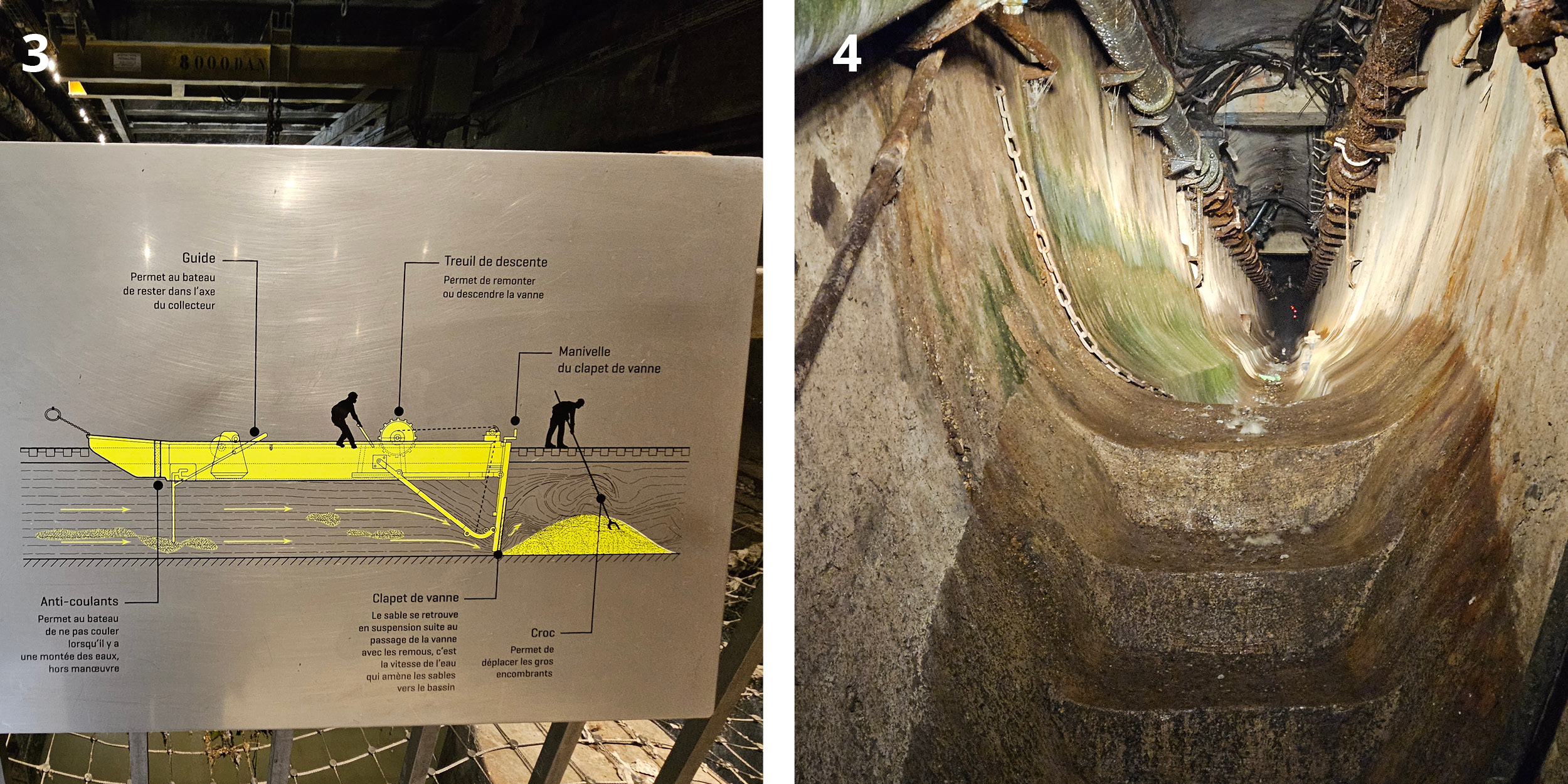
17 May 2024: Hallo from Germany!
I spent a very big week in Munich visiting IFAT, the largest water and waste trade fair in the world. It is truly jaw-dropping and like nothing I’ve ever seen. The venue is so large there is a train station at either end. The following photo shows one of the trade show pavilions… and there are 18 of them! In addition, the large equipment and demonstration area was set up outside, and that occupied a further 12ha. Mind-blowing stuff!
Inside the pavilions, I was amazed at the breadth of equipment available and the quality of the technology. A process engineer’s dream! The mixers, aerators, centrifuges, belt filter presses, thermal driers and solar driers were of particular interest to me. From the conversations I had with the equipment vendors, it was also interesting to learn which technologies are preferred in different regions, as they typically supply throughout Europe, Asia and the Arab States.

In addition to the exhibitors, there were many informative sessions on topics such as the German water sector, hydrogen, waste to energy, PFAS and contaminants, circular economy, and industry associations. I found these particularly useful, as they provided a bigger picture than what individual technology providers could. These sessions helped me to develop an understanding of sludge management in Germany, how Germany compares with other European countries, and key issues for the future.
I met with some wonderful specialists from around the world and had many conversations about the similarities and differences between approaches to biosolids and organic waste management. There are certainly many similarities (contaminants, nutrient management, circular economy), but it has been particularly interesting to learn how much a country’s regulation is influenced by their environment, population and historical land use. Regulation is not transferable without understanding local context!
Lastly, I got my first taste of recycled water (in beer form). Xylem makes Reuse Brew and it was a hit at the show!
24 May 2024: Hallo from Austria!
This week has been spent in the picturesque Austrian countryside, touring wastewater treatment plants (WWTPs), anaerobic digesters and composting facilities. My generous host was Horst Müller, Director of MüllerUmwelttechnik (Müller Environmental Engineering) and Chair of the European Federation for Agricultural Recycling.
Similar to RMCG, MüllerUmwelttechnik is a consulting company that undertakes assessments for the land application of biosolids, completing soil sampling and preparing application management plans to meet regulatory requirements. In addition, they design composting facilities and anaerobic digestors, with a particular interest in dry anaerobic digestion technology.
I stayed at a delightful village in Upper Austria, a couple of hours west of Vienna, towards the German border. The facilities we toured service small- to medium-sized populations, which reflects the local landscape – homes and businesses clustered in small villages, surrounded by a tapestry of cereal crops, forests and waterways. The crops are densely planted right up to the roadside, and farm animals are primarily housed in barns. The farms are small (typically 5–50ha), but production is intense and diverse.

As a result, Austria has many excellent examples of local, circular resource use. Small mechanical WWTPs treat combined stormwater and sewage from a village, typically with biological nitrogen reduction and alum or ferric dosing for phosphorus reduction. Sludges undergo stabilisation and/or composting, prior to land application.
Other local feedstocks are available for co-processing, including agricultural wastes (crop residuals and manure from barns), wood chips, green waste and FOGO. Anaerobic digestion (AD) is common as there are plenty of good feedstocks and demand for heat and renewable electricity, and digestate is applied on local farms. Although WWTPs are government owned and operated, many of the AD and composting facilities are part of integrated businesses, such as farms, plant nurseries and seed oil processors.

Above: The Trattnachtal wastewater treatment plant treats primary sludge, WAS and industrial food waste in its anaerobic digestion facility. Digestate is dewatered with a centrifuge and spread onto local farms. Biogas is used to heat the digesters and generates electricity for the site and local houses.
It was very interesting to see the success of small-scale systems, treating local wastes and using residuals on local farms. Austrians are mindful of the costs and greenhouse gas emissions from transporting bulky waste streams, and therefore large, centralised facilities located a long way from where wastes are produced are not preferred. In fact, Vienna has a waste incinerator in the centre of the city! The Spittelau Incinerator burns local wastes and provides electricity and heat to Viennese homes.
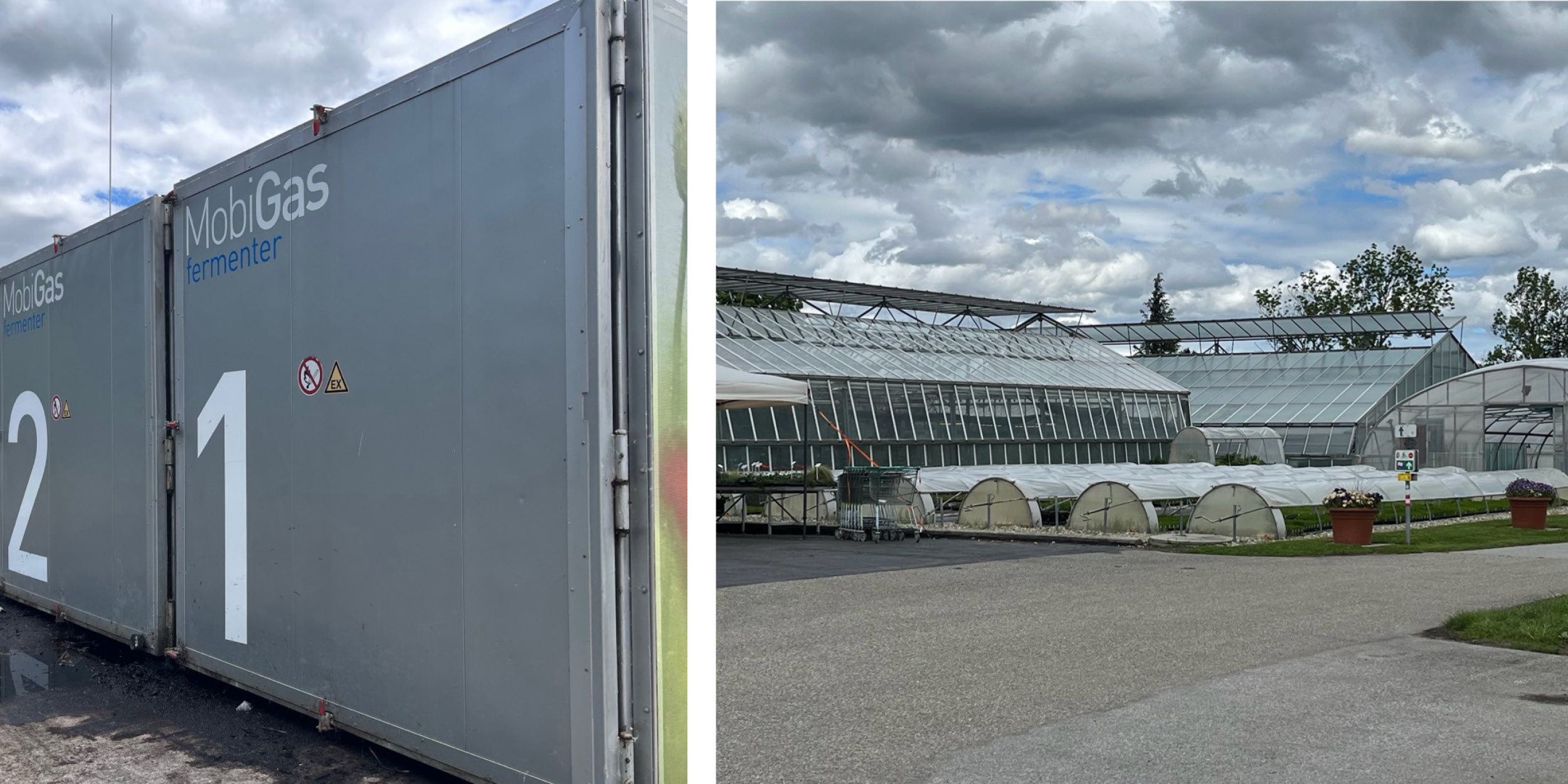
Above: Dry AD cells at Drexler Horticulture. This business grows seedlings for residential and commercial customers and operates the dry anaerobic digestion cells and a compost facility as part of its operations. Compost is used onsite and sold, and biogas provides heat to the greenhouses.
31 May 2024: Hej from Denmark!
Denmark was included in my itinerary so that I could visit sludge treatment reed beds (STRBs) and learn about their design and operation from international expert, Steen Nielsen. I first heard about STRBs a few years ago and thought they would be very well suited to medium-sized mechanical WWTPs in regional Australia. But without any systems in Australia, I had to take this opportunity to visit some!
STRBs are a low-energy technology that stabilise and dewater sludge. They are particularly well suited to treating secondary waste activated sludge (WAS). A system consists of a set of reed beds, usually 10 or more. Each bed has a liner and a gravel drainage layer, topped with growing media (soil or dewatered biosolids) which is planted with reeds. WAS is pumped from the bioreactor into one bed at a time, putting a thin film over the bed before moving to the next. The sludge dewaters over time, with high-quality filtrate flowing through to the underdrain system, returning to the WWTP for re-processing.
Some of the aspects of this technology I find remarkable are:
- They are passively aerated by the hollow reeds and filtrate pipes, which extend up to the surface along one side of each bed. No energy is needed for mechanic/forced aeration.
- The systems are designed for a minimum 10 year operating cycle, so that once constructed, they store at least 10 years of sludge and then only one bed is emptied each year. In Steen’s experience, beds often achieve operating periods beyond this, depending on sludge dewatering characteristics and climate.
- They are incredibly low energy, with power only needed for pumping WAS to the beds, returning filtrate to the WWTP, and for digging out the biosolids.
- They require no chemicals at all.
- In Europe, they achieve 20-40% dry solids in the finished biosolids, but in hotter climates can achieve up to 50% dry solids.
- The resulting biosolids are stable, odourless, friable and nutrient rich. In fact, the biosolids become better fertiliser over time, as chemically-bound phosphorus is mineralised, resulting in an increase in plant-available phosphorus in the final biosolids.

L-R: Air ventilation pipes (which become the filtrate pipes) and valves on the sludge loading (influent) pipelines, located in a dry well adjacent to the reed beds.
Of course, these benefits come at a cost of surface area, with STRB system requiring a similar footprint as the rest of the WWTP infrastructure. But considering they replace all the steps in sludge treatment (thickening, digestion, dewatering and 10 years of biosolids storage), perhaps their footprint isn’t so large in comparison to what would be needed otherwise. Nonetheless, they are suited to sites that have space, or where additional land is available. In Denmark, there are STRB systems located up to 4km from a WWTP, with a dual pipeline (one for WAS, one for filtrate) connecting the two sites.
Steen and I visited three operating STRB sites and it was brilliant to see how different they are to conventional sludge treatment systems. These sites had wildflowers, lush reeds, no odours, no trucks and silence – bliss!

8 June 2024: Hello from the UK!
A highlight of this week was a trip to the Davyhulme Wastewater Treatment Works, the largest sludge processing facility in the UK! I had two wonderful hosts: Rick Lancaster, Global Bioresources Director, AtkinsRéalis, and Dr Ali Osman, Production Manager, United Utilities.
Primary and secondary sludge from the onsite treatment works, along with dewatered sludge imported from the surrounding region, are all treated here. That’s more than 100,000 dry tonnes of biosolids a year, servicing an equivalent population of around 5 million people! At this scale, advanced technology is necessary to keep the footprint low and the production rate high.

The facility uses the Cambi system, a thermal hydrolysis process (THP) which breaks down sludge prior to anaerobic digestion. The THP reduces digester residence time, improves biogas recovery and enhances sludge dewaterability, making it a critical process addition for a facility of this size. The resulting dewatered biosolids from this facility are applied to farmland, with a team of people managing logistics, regulatory compliance and farmer relationships.
Two giant orbs dominate the site – these are the biogas storage tanks. Five combined heat and power (CHP) engines generate a whopping 8MW of renewable electricity and all the heat needed for the facility. What a powerhouse of productivity!

Later in the week I spent a day with organic waste specialist Dr Jane Gilbert, Carbon Clarity. Jane has a wealth of knowledge in composting and digestate management, and has helped to develop some excellent documents for the International Solid Waste Association, the European Compost Network, and training material for the Chartered Institution of Wastes Management.
We visited the Biogen Bygrave Anaerobic Digester, located about 65km north of London. Compliance Director Kate Lister kindly showed us around the site, which processes 54,000 tonnes/year of food waste and generates renewable electricity and stabilised liquid digestate. Along with the waste receival facility and process tanks, two huge storage tanks are used for holding digestate outside of the allowable spreading season (February to September, although this can be shortened by wet weather). Their scale was impressive.

I ended the week in London, meeting with bioresource specialist Matt Stewart, who works with Rick at AtkinsRéalis, and happens to be Australian. It was great to discuss the similarities and differences between biosolids management in Australia and the UK, and compare notes on working overseas. It’s conversations like this that have really helped me to consolidate my learnings and form a more wholistic picture of international approaches to biosolids management.
12 June 2024: Bonjour/Hallo from Belgium!
This week I completed my final week of Fellowship travel. I caught the train from London to Brussels, arriving in this wonderfully historic city known as the “Capital of Europe” due to the many EU institutions that are based here. The purpose of my time in Brussels was to meet with EU water and biosolids organisations.
As Chair of the European Federation of Agricultural Recycling (EFAR), Horst Muller, my contact in Austria, had arranged for me to meet with other EFAR delegates. After lunch, we also attend a meeting with representatives from the European Federation of National Associations of Water Services and the European Association of Public Water Operators.
The purpose of this meeting was to discuss details regarding a comprehensive EU-wide biosolids contaminant sampling program, with the goal of providing insights into a broader range of contaminants than are currently regulated, and to provide comparable data across all EU countries. It was interesting to listen to the discussion on the range of contaminants to be tested, and the logistics involved in conducting such a large-scale sampling program.

European Parliament buildings.

Meeting with EFAR, EurEau & Aqua Publica Europea delegates (our meeting location was a little less grand than the EU Parliament!)
I also had the opportunity to present on the purpose of my Fellowship, how biosolids are managed in Australia and what I have learnt during my travels. It was great to have the opportunity to reflect on the similarities and differences in approaches, and I have come to the conclusion that our issues and opportunities have a lot in common. There certainly isn’t a single solution; instead, there are many pathways to achieving beneficial use which navigate regulatory requirements, user needs and affordability.
Now that I have concluded my travel, I am required to prepare a report for the Trust, which will be published on their website. I will let you know when it’s available. In addition to the topics I have covered in these blog posts, I have also investigated regulation and several key contaminants (PFAS, microplastics), and these will be detailed in my report. A few of you had requested this and I shall deliver!
In addition to the report, I will seek out opportunities to share my experience and learnings with others in the Australian water sector. Please let me know if you have any specific questions – I’m always happy to talk biosolids.

For more information, you can contact Hilary at hilaryh@rmcg.com.au or 0422 608 303.


